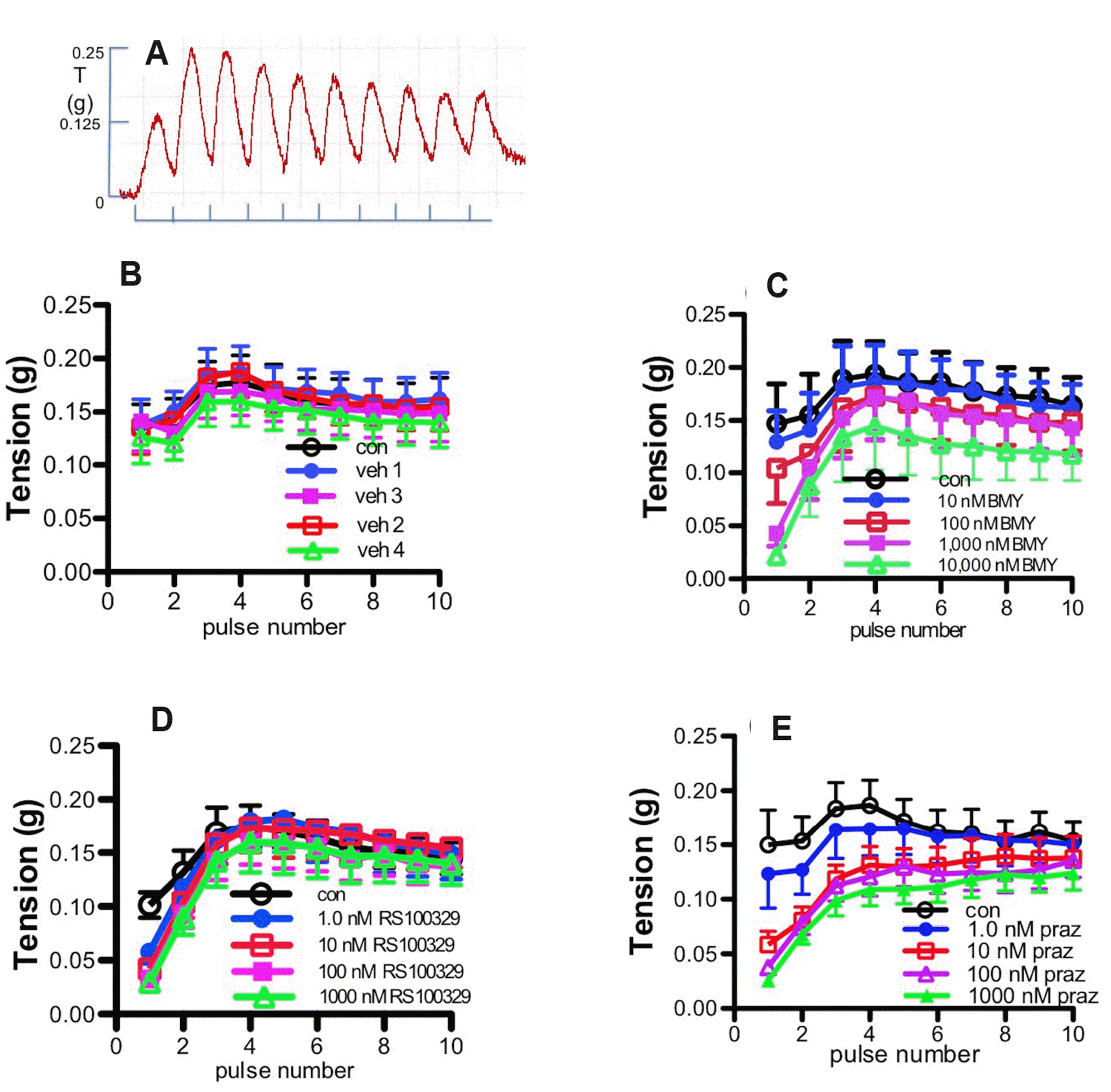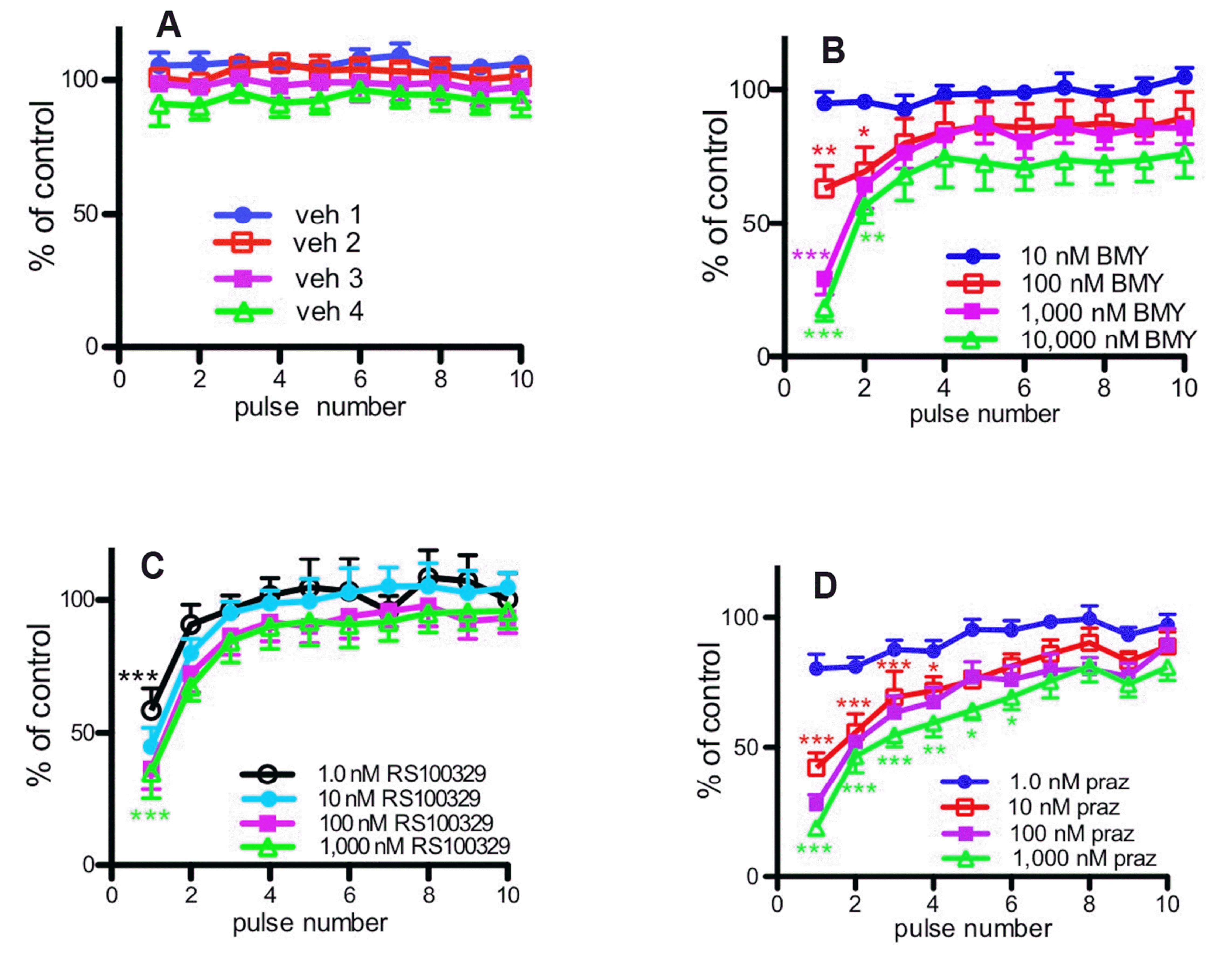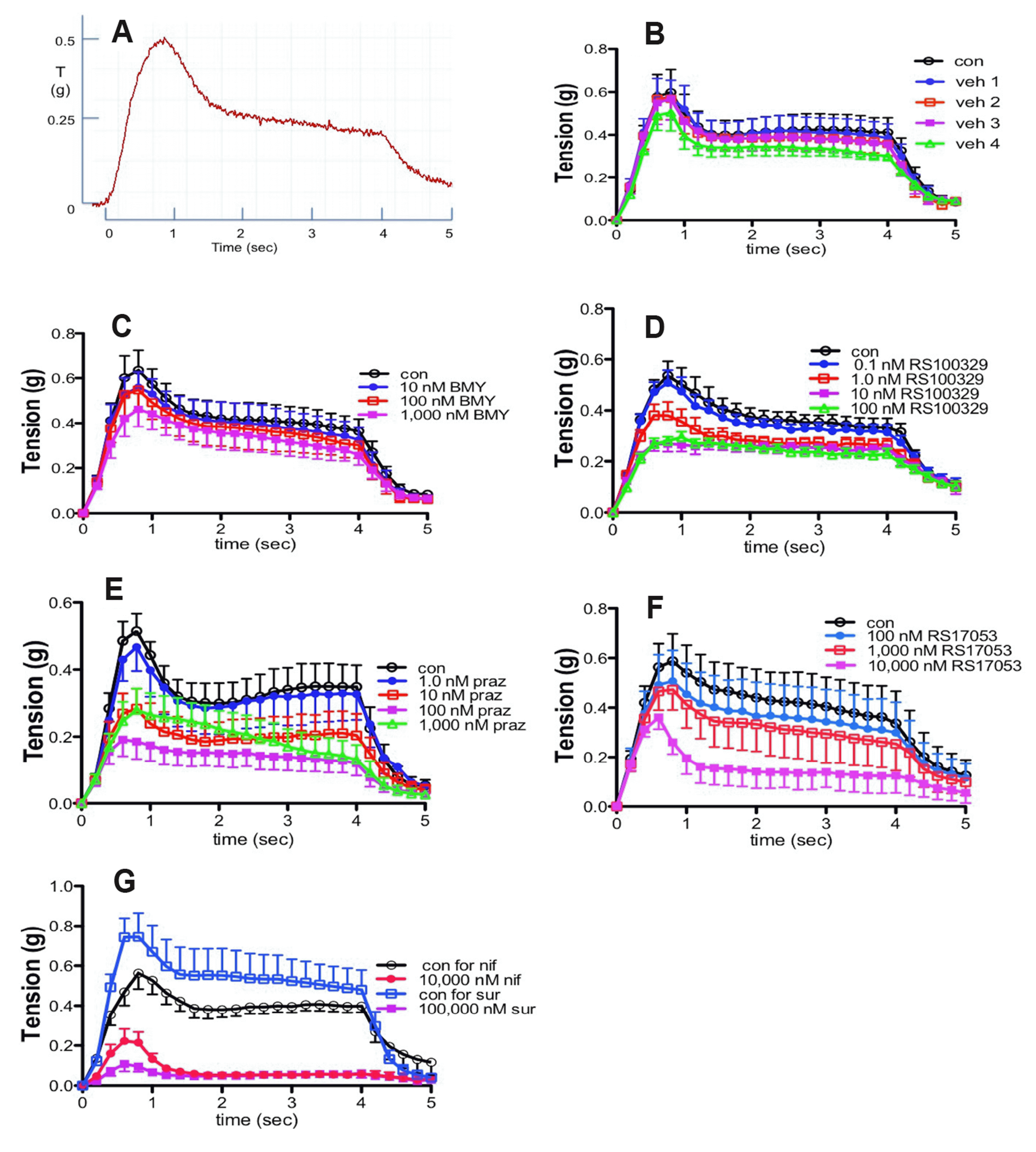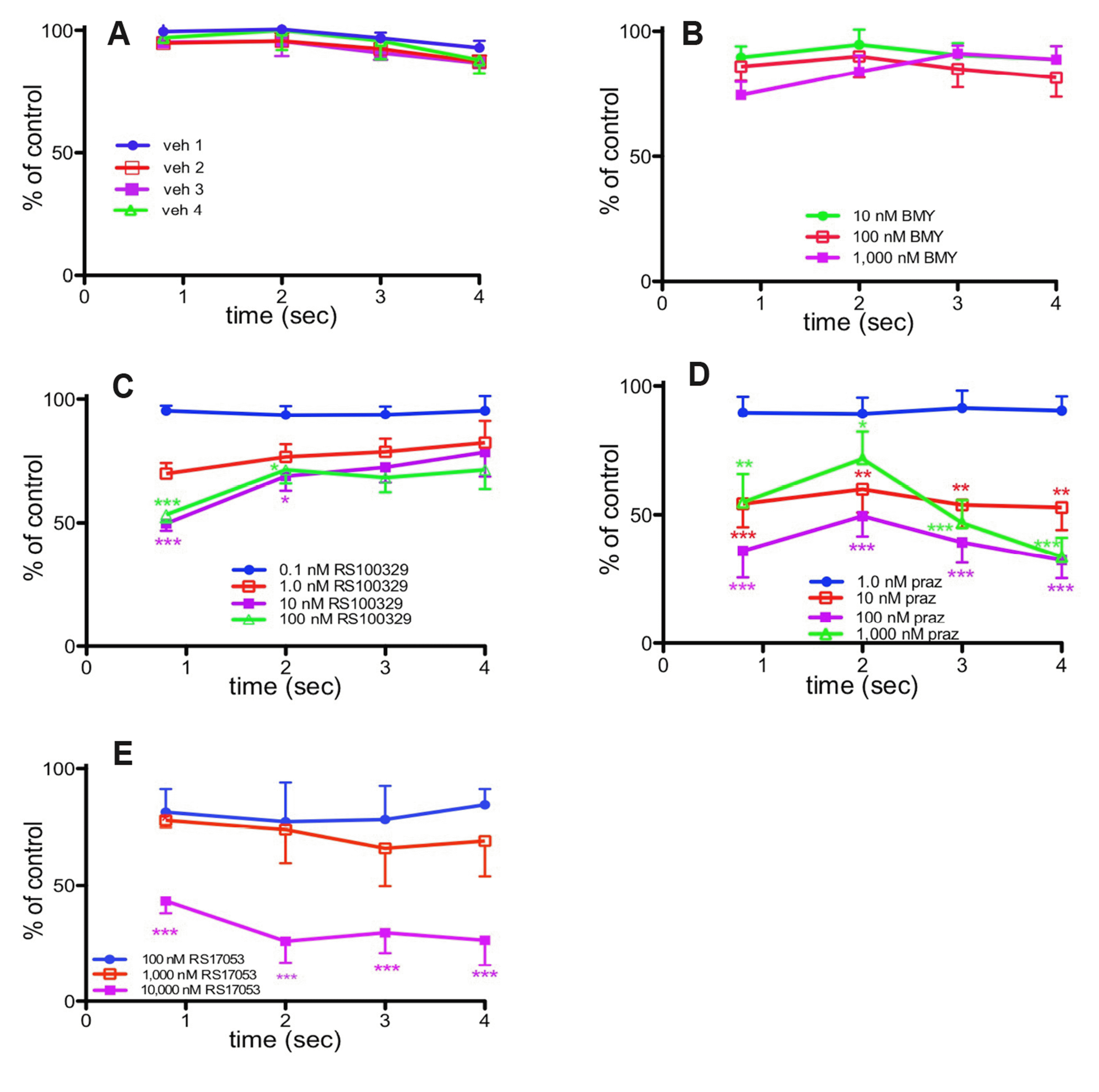METHODS
Animals
Male C57 mice (18–25 g) were obtained from the Royal College of Surgeons in Ireland (RCSI) Biomedical Facility. All studies have been approved by the Health Products Regulatory Agency (HPRA) in Ireland and by the RCSI Research Ethics Committee. The animals were housed in a controlled environment with a 12-h light, 12-h dark cycle and were fed a standard rat diet.
Preparation of the isolated mouse vas deferens
Animals were killed by overdose of CO2. For removal of vas deferens, a midline incision was made in the abdomen and the testis and epididymis exposed. Blunt forceps were placed to separate the vas deferens from the connective tissue. The whole vas deferens was tied with a long thread at the epididymal end and a short thread at the prostatic end, removed and carefully cleared of connective tissue. By convention, the vas was always placed in organ baths between platinum electrodes with the epididymal end attached to a transducer (Grass FT03) under 1 g tension in organ baths at 37°C in Krebs-Henseleit solution of the following composition: (mM): NaCI 119; NaHC03 25; D-glucose 11.1; KCl 4.7; CaCl2 2.5; KH2P04 1.2; MgS04 1.0.
Experimental protocol
Bathing fluid was changed every 15 min, except during cumulative antagonist administration. Following 60 min equilibration, changing bathing fluid every 15 min, tissues were stimulated electrically at 5 min intervals with 10 pulses at 1 Hz or 40 pulses at 10 Hz (0.5 ms pulses, supramaximal voltage) using a Grass S88 stimulator. When consistent responses in terms of magnitude and time course of isometric contraction had been obtained, antagonists were added in increasing cumulative concentrations in 1 log unit increments at 5 min intervals beginning immediately after a period of stimulation, and stimulation was repeated 5 min later in the presence of the antagonist concentration. Responses were obtained to 10 pulses at 1 Hz and 40 pulses at 10 Hz in separate experiments since high frequency stimulation reduces responses to particularly the first pulse at 1 Hz.
Following the control stimulation-evoked contraction (the response obtained immediately before the first addition of vehicle or antagonist), four cumulative additions of antagonist were carried out in 1 log unit increments for RS100329 (10–10M–10–7M), BMY7378 (10–8M–10–5M), prazosin (10–9M–10–6M) and RS17053 (10–7M–10–5M), and in vehicle experiments 4 cumulative additions of vehicle were given (veh 1–veh 4). Hence, the first vehicle (veh 1) is the vehicle that was compared with RS100329 (10–10M), BMY7378 (10–8M) and prazosin (10–9M), etc. RS17053 was employed only in 10 Hz studies.
Contractions were calculated as absolute tension (g). Graphs showing the response to each pulse at 1 Hz and the time course of contractions at 10 Hz (at 0.2 sec intervals) were plotted from mean data obtained.
The effects of the four α1-adrenoceptor antagonists on the response to 10 Hz were compared directly with the effects of vehicle by expressing responses in the presence of antagonist or vehicle as a percentage of the relevant control response at 4 time points: 0.8 sec (peak), 2.0, 3.0 & 4.0 sec (plateau).
Drugs
BMY7378 (8-[2-(4-(2-methoxyphenyl) piperazin-1-yl)ethyl]-8-azaspiro[
4,
5]decane-7,9-dione) (Tocris, Bristol, UK); RS17053 (N-[2-(2-Cyclopropylmethoxyphenoxy)ethyl]-5-chloro-α,α-dimethyl-1H-indole-3-ethanamine hydrochloride) (Tocris); RS100329 (5-methyl-3-[3-[4-[2-(2,2,2,-trifluoroethoxy)phenyl]-1-piperazinyl]propyl]-2,4-(1H)-pyrimidinedione) (Tocris); nifedipine (Sigma, Dublin, Ireland); prazosin hydrochloride (Sigma); suramin hexasodium salt (Tocris).
Drug stocks were dissolved in distilled water, except for nifedipine and RS17053 which were dissolved in ethanol.
Statistics
Values are expressed as mean ± standard error of mean (SEM) from 6 experiments except for the studies with nifedipine and suramin, where n = 5, and with RS17053, where n = 4. The minimum level for statistical significance was p < 0.05. Differences between test antagonists and vehicle were compared using the GraphPad Prism program (GraphPad Software Inc., San Diego, CA, USA) for MacIntosh by two way ANOVA for multiple groups, and, only when ANOVA showed significance of p < 0.05, with Bonferroni test for comparison of effects with control or the vehicle group. Antagonist potency at producing 50% inhibition of contractions (pIC50 value, –log M) to a single pulse, 1 Hz or 10 Hz stimulation was calculated from individual experiments by non-linear regression using GraphPad Prism for MacIntosh.
Go to :

DISCUSSION
In this study, we have examined α
1-adrenoceptor subtypes involved in contractions of mouse vas deferens, employing the α
1A-adrenoceptor antagonist RS100329 [
6], the α
1D-adrenoceptor antagonist BMY7378 [
7], the non-selective antagonist prazosin [
3,
8] and the antagonist RS17053 [
9].
This study relies on the selectivity of antagonists. BMY7378 has high potency at α
1D-adrenoceptors (average of 8.60, –log M), but low potency at α
1A- and α
1B-adrenoceptors (average of 6.55 and 7.07, respectively) [
8]. Conversely, RS100329 has high potency (average of 9.40) at α
1A-adrenoceptors, but low potency (average of around 8.15) at other α
1-adrenoceptors (α
1B- or α
1D-adrenoceptors) [
8]. Allowing for sub-optimal conditions, BMY7378 (10
–8M–10
–7M) and RS100329 (10
–9M–10
–8M) might be expected to produce selective actions at α
1D- and α
1A-adrenoceptors, respectively. The major problem in terms of α
1-adrenoceptor antagonist selectivity is the absence of a reliable selective α
1B-adrenoceptor antagonist. Currently, there is no reliable selective antagonist for α
1B-adrenoceptors [
8]. However, studies with the antagonist RS17053 suggest that this antagonist has a different profile of action to the other antagonists, and this will be discussed below. Given the uncertainty about selectivities of α
1B-adrenoceptor antagonists, actions of low concentrations of prazosin not shared by low and subtype selective concentrations of BMY7378 or RS100329 (at the above concentrations) can be presumed to involve α
1B-adrenoceptors [
10,
11]. We have previously demonstrated in rat spleen that actions of prazosin were greater than the combined effects of selective concentrations of BMY7378 and RS100329, suggesting the involvement of α
1B-adrenoceptors in contractions [
11]. In rat portal vein, no α
1D-adrenoceptors could be demonstrated, but prazosin had differing actions from RS100329, again suggesting involvement of α
1B-adrenoceptors, particularly in tonic contractions [
10]. Hence, this strategy is able to identify α
1B-adrenoceptor mediated responses.
RS17053 has relatively high affinity at α
1A-adrenoceptor ligand binding sites of 7.5–8.5 (–log M) [
9,
12], and lower affinity at α
1B- and α
1A-adrenoceptor (7.3 & 7.1, respectively) [
9]. The functional selectivity of RS17053 is less clear. RS17053 has high potency at α
1A-adrenoceptors in CHO cells (8.24) [
13], intermediate potency at α
1B-adrenoceptors in CHO cells (7.63) [
13] and rat spleen (7.2, 7.28) [
13,
14], and similar or lower potency at α
1D-adrenoceptors (noncompetitive in rat aorta) [
14]. In rat portal vein, where contractions involve both α
1A- and α
1B-adrenoceptors [
10], RS17053 markedly reduced contractions over the concentration range 10
–7M–3 × 10
–6M [
14].
In the present study, it can be clearly seem from the effects of BMY7378 (10
–7M) against a single pulse (first pulse at 1 Hz) and against low frequency (1 Hz) stimulation that an α
1D-adrenoceptor mediated response is present only to the first pulse. This component can be clearly seen in the biphasic response of mouse or rat vas deferens to a single electrical stimulus [
2,
15]. Hence, the first stimulus in a train provokes the α
1D-adrenoceptor response involving T-type Ca
2+ channels and stores of calcium and these stores are then either depleted or the system inactivates [
15]. However, the response to the first pulse at 1 Hz is also significantly inhibited by low concentrations of RS100329 (10
–9M), so that the initial response at 1 Hz involves both α
1A- and α
1D-adrenoceptors. Prazosin has more effect that either BMY7378 or RS100329 alone, presumably by combined actions at both α
1A- and α
1D-adrenoceptors, or possibly by additional actions at α
1B-adrenoceptors.
In terms of responses to 10 Hz stimulation, BMY7378 had no significant effect at selective concentrations. Admittedly, BMY7378 reduced the peak response but this did not reach significance. The α1D-adrenoceptor component to the response seen with 1 Hz stimulation is not well maintained by a high frequency stimulation protocol, presumably by exhaustion of the calcium stores. RS100329 (10–8M) inhibited the peak response to 10 Hz stimulation, demonstrating an α1A-adrenoceptor mediated component. However, RS100329 even in higher concentrations did not significantly affect the plateau response to 10 Hz stimulation. This suggests that α1A-adrenoceptor activation may have only a small effect on the plateau response. However, prazosin (10–8M) markedly reduced both the peak and plateau response to 10 Hz stimulation, demonstrating that α1B-adrenoceptors are involved in the plateau response. Most interestingly, RS17053 markedly reduced the plateau response revealing a greatly increased peak (in terms of the ratio of peak to plateau). None of the other antagonists had this action. RS17053 shows selectivity for α1A- over α1B-adrenoceptors, but lowest potency at α1D -adrenoceptors (see above). Hence, these actions of RS17053 are consistent with actions mainly at α1A- and α1B-adrenoceptors, and so differ from the effects of prazosin in that, lacking α1D-adrenoceptor antagonist potency, RS17053 leaves a clear peak response. Components of the response to 10 Hz stimulation are summarized in the graphical abstract.
In terms of potency at producing 50% inhibition of contractions, prazosin had similar potencies (7.7–8.0) at inhibiting the contraction to a single pulse and the peak and plateau contractions to 10 Hz stimulation, and this demonstrates that prazosin acts as a non-selective antagonist at all 3 subtypes of α1-adrenoceptor. Like prazosin, RS17053 inhibited both the peak and plateau contractions to 10 Hz stimulation, although with much lower potency (5.2–5.7) than prazosin. In contrast, RS100329 showed slightly higher inhibitory potency than prazosin (8.2–8.5) against both the contraction to a single pulse and the peak contraction to 10 Hz stimulation, suggesting that these responses are mainly α1A-adrenoceptor mediated. However, RS100329 did not produce significant inhibition of the plateau response to 10 Hz stimulation. BMY7378 significantly inhibited only the response to a single stimulus, with a pIC50 of around 6.6, showing that α1D-adrenoceptors have a minor role in contractions.
However, α
1-adrenoceptors interact with P2X1-purinoceptors in producing contractions of mouse vas deferens. The P2X1-purinoceptor mediated response involving an intrinsic ion channel, depolarization and Ca
2+ entry through nifedipine-sensitive calcium channels [
16] and contractions to ATP are absent in vas deferens from P2X1-KO mice [
17]. Suramin, a P2X1-purinoceptor antagonist, virtually abolishes the plateau response to 10 Hz stimulation, leaving mainly a small peak response. We cannot rule out the possibility that suramin in the high concentration of 10
–4M may have other actions at this high concentrations, but, assuming that actions are mainly at P2X1-purinoceptors, this demonstrates that the plateau response which partly involves α
1B-adrenoceptors is also P2X1-purinoceptor mediated. We have previously shown that tonic contractions of rat portal vein involve predominantly α
1B-adrenoceptors, and are at least partly mediated by mechanisms involving RhoA/Rho kinase [
10]. RhoA activation causes inhibition of myosin light chain phosphatase to increase vasoconstriction by Ca
2+ sensitization [
18]. Hence, it is likely that the main action of activation of α
1B-adrenoceptors in mouse vas deferens is to facilitate P2X1-purinoceptor mediated contractions.
Although earlier studies failed to find evidence for α
1B-adrenoceptors in rat vas deferens by Northern blot [
19], more recent studies using real time reverse transcription polymerase chain reaction have shown expression of α
1B-adrenoceptors in rat vas deferens and particularly in the epididymal portion, where expression was greater than for α
1D-adrenoceptors [
20].
Prazosin in the high concentration of 10
–6M acted to reverse the inhibition of 10 Hz stimulation-evoked contractions achieved by 10
–7M (see
Figs. 3E and
4D), and increased particularly the early component of the response. This action of high concentrations of prazosin is probably due to α
2-adrenoceptor antagonism to block negative feedback inhibition of neurotransmission by the neurotransmitter NA: NA acting at presynaptic receptors on the nerve terminals reduces transmitter release, so that blockade of these receptors increases release. The α
2-adrenoceptor antagonists yohimbine and BRL44408 have been shown to potentiate the early component of contractions to 10 Hz stimulation in mouse vas deferens [
21].
α
1A-Adrenoceptor knockout caused a 50% loss of fertility, triple α
1-adrenoceptor knock-out a 92% loss, P2X1 purinoceptor knockout an 86% loss, and combined P2X1/α
1A-receptor knockout produced 100% loss of fertility [
5,
17,
22]. These changes were caused by diminished sperm in the ejaculate [
17,
22]. Previous studies of male fertility have examined α
1-adrenoceptor antagonists. In rats, the non-selective α
1-adrenoceptor antagonist phenoxybenzamine (0.7 mg/kg for 5 weeks) caused infertility with increased spermatozoa number in the epididymis and vas deferens [
23], and phenoxybenzamine (20 mg/day) produced similar effects in man and was also useful against premature ejaculation [
24]. In rats, prazosin (1.4 mg/kg) significantly reduced sperm count [
25], but in man, prazosin in the lower dose of 5 mg (approx 0.1 mg/kg) was ineffective as a male contraceptive [
26]. It has been suggested that P2X1-purinoceptor blockade alone [
27] or combined with α
1A-adrenoceptor blockade could prove useful as a male contraceptive [
5]. In mice, α
1A-KO or α
1D-KO, but not α
1B-KO, reduces resting blood pressure [
8]; hence, α
1B-adrenoceptor blockade may have lesser effects on blood pressure.
These results suggest that there is a relatively minor early α1D-adrenoceptor and a larger α1A-adrenoceptor component to stimulation-evoked contractions of mouse vas deferens, but the major α1-adrenoceptor component is revealed to be α1B-adrenoceptor mediated by the non-selective antagonist prazosin. α1B-Adrenoceptors mediate contractions and/or facilitate contractions to other α1-adrenoceptor and purinoceptor activation. These results suggest that combined non-selective α1-adrenoceptor blockade, particularly α1B-adrenoceptor blockade, in addition to P2X1 purinoceptor blockade may be useful in reducing contractility of vas deferens, and may have lesser effects on blood pressure than selective α1A-adrenoceptor antagonism.
Go to :









 PDF
PDF Citation
Citation Print
Print


 XML Download
XML Download